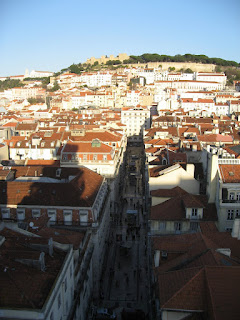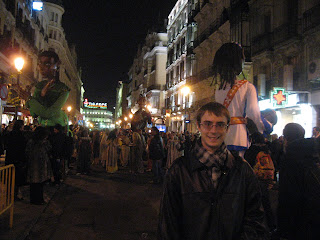
View of the Lisbon coast from on top the Discoveries monument. They had a nice 'Golden-Gate' like bridge, and lots of sail boats all over. The boardwalk you see was also packed with bikers, walkers, fishermen, and people of all types. As you can see, we had great luck with weather. It was early February when we went there, and we experienced near 70 degree temperatures during the two days we were there.


This is the monastery of San Jeronimo with the city in the background and a nice park in the foreground.

Monument of the Discoveries. For all of the famous discoverers who came from Portugal... I remember Vasco de Gama... what a guy. We actually went on top of this monument too to get some cool shots of the surrounding city and coastline.

This is the Tower of Belem. Really old. It's complete with a dungeon and an array of ancient canons that used to shoot the living daylights out of anything that entered Portuguese harbors.
We decided a while ago that we wanted to visit Lisbon, Portugal, because it's close, and because we figured that if we're going to take a trip around Europe that Portugal is kind of out of the way. So, we figured out a quick trip to go there and visit for a three-day weekend. We flew there from Madrid, which didn't take long (a little over an hour, actually, and we got that hour back flying across a time zone).
Lisbon is a very beautiful city that has its own definite style and flavor apart from Spain. Some of the colors of the city and the look were similar (for example: the stone tiled walkways, the red tile roofs, the apartments upon apartments, the grand plazas, the outdoor cafes, etc.), however, many things were very different. The language, for one, which on paper looks a lot like Spanish, is virtually unrecognizable for a moderate level Spanish speaker like myself. It sounds like a mix of Chinese and Spanish. Abby and I got by on a mix of English and Spanish. It was quite amusing actually, because I think that many people were confused as to just who the heck we were and where we were from.
Lisbon is a very international city. We saw people from all over while we were there, including a number of different couples from the States. We had been told before going there that Portugal was a little behind the rest of Europe as far as restoring all of their old buildings... and after going there, I guess I would agree. Everything seemed to need at least a fresh coat of paint. We didn´t see as much construction or restoration there as anywhere else we´ve gone. Maybe this is because they´re not getting around to it at this moment. I don´t know.
The style of their buildings and apartments is simpler than the Spanish style. Many Spanish buildings have a romantic twist to them, whereas the Portuguese were more basic... more flat.

The castle is on the hill (Castillo de San Jorge, I think). Anyways, we saw it from the top of this famous elevator (Ascendor de Santa Maria). There was a nice little cafe and live music at the top of this elevator in the middle of the old part of Lisbon. The view was definitely worth the ride up.

Here I am standing in one of the main plazas in the south of the city, near the harbor. In the background are a couple of other famous monuments in Lisbon--dude on a horse and the Arch.

Our timing was impeccable, and we caught a nice sunset going down under the bridge on our first night.

This is the elevator of Santa Maria that I was telling you we went to the top of before. I think that it's around 100 years old... which is pretty incredible.


This is the tower of Vasco de Gama. This is located in the new part of the city, next to malls and restaurants and modern hotels. There's also a really long bridge there by the same name (Vasco de Gama) that I swear must be at least a few miles long. We were there during night, so it was difficult to see it in its entirety.
 Hi. So alright, this is a skiing trip that Abby and I went on. We found out through some friends about a company that provides transportation and lift tickets to some ski resorts in the Pyrenees Mountains (east of where we are in Spain). We decided to go on a day-trip to the province of Huesca in the autonomous community of Aragón. The ski resort was called Formigal, and it was fairly big... with somewhere in the range of 30 runs or more. We left early in the morning and came back after it started to get dark.
Hi. So alright, this is a skiing trip that Abby and I went on. We found out through some friends about a company that provides transportation and lift tickets to some ski resorts in the Pyrenees Mountains (east of where we are in Spain). We decided to go on a day-trip to the province of Huesca in the autonomous community of Aragón. The ski resort was called Formigal, and it was fairly big... with somewhere in the range of 30 runs or more. We left early in the morning and came back after it started to get dark.

























